Ethics, Sustainability, and Circular Economy in Malaysia
VerifiedAdded on 2022/12/23
|12
|3886
|1
Report
AI Summary
This report provides a comprehensive overview of the circular economy, its emergence, and its principles. It delves into the development of the circular economy in Malaysia, highlighting the factors, barriers, and opportunities within the Malaysian context. The report examines the benefits of adopting a circular economy, including waste reduction, resource efficiency, and economic growth. It also explores the role of companies and the government in supporting the circular economy through various measures and provides key recommendations for government ministries. The report emphasizes the importance of ethical considerations, sustainability, and social impact in the context of a circular economy, discussing concepts like the cradle-to-cradle model and the blue economy to reduce waste and promote sustainable practices. The study also highlights the potential of circular economy to contribute to economic enhancement, decreased energy consumption, and environmental protection in Malaysia.
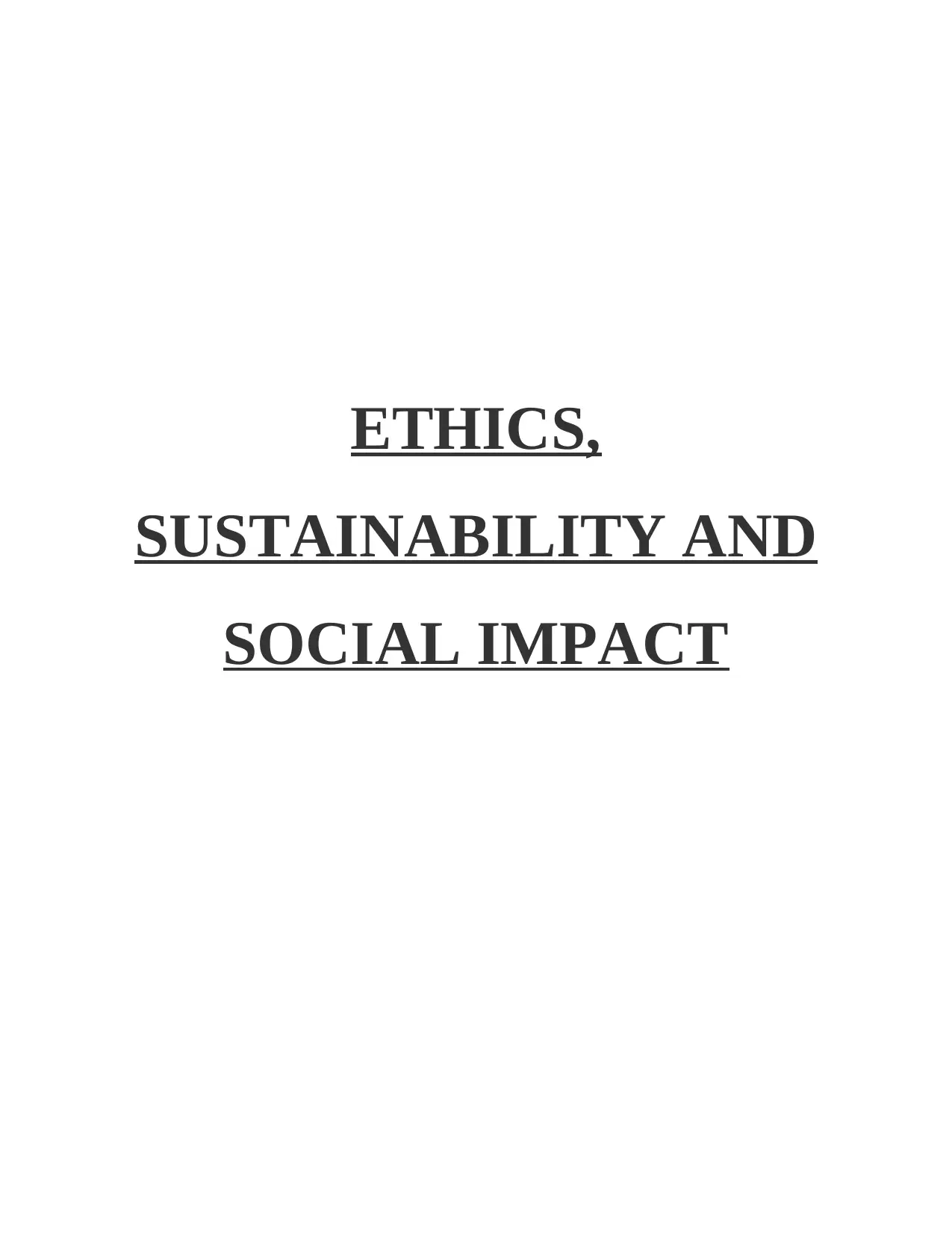
ETHICS,
SUSTAINABILITY AND
SOCIAL IMPACT
SUSTAINABILITY AND
SOCIAL IMPACT
Paraphrase This Document
Need a fresh take? Get an instant paraphrase of this document with our AI Paraphraser
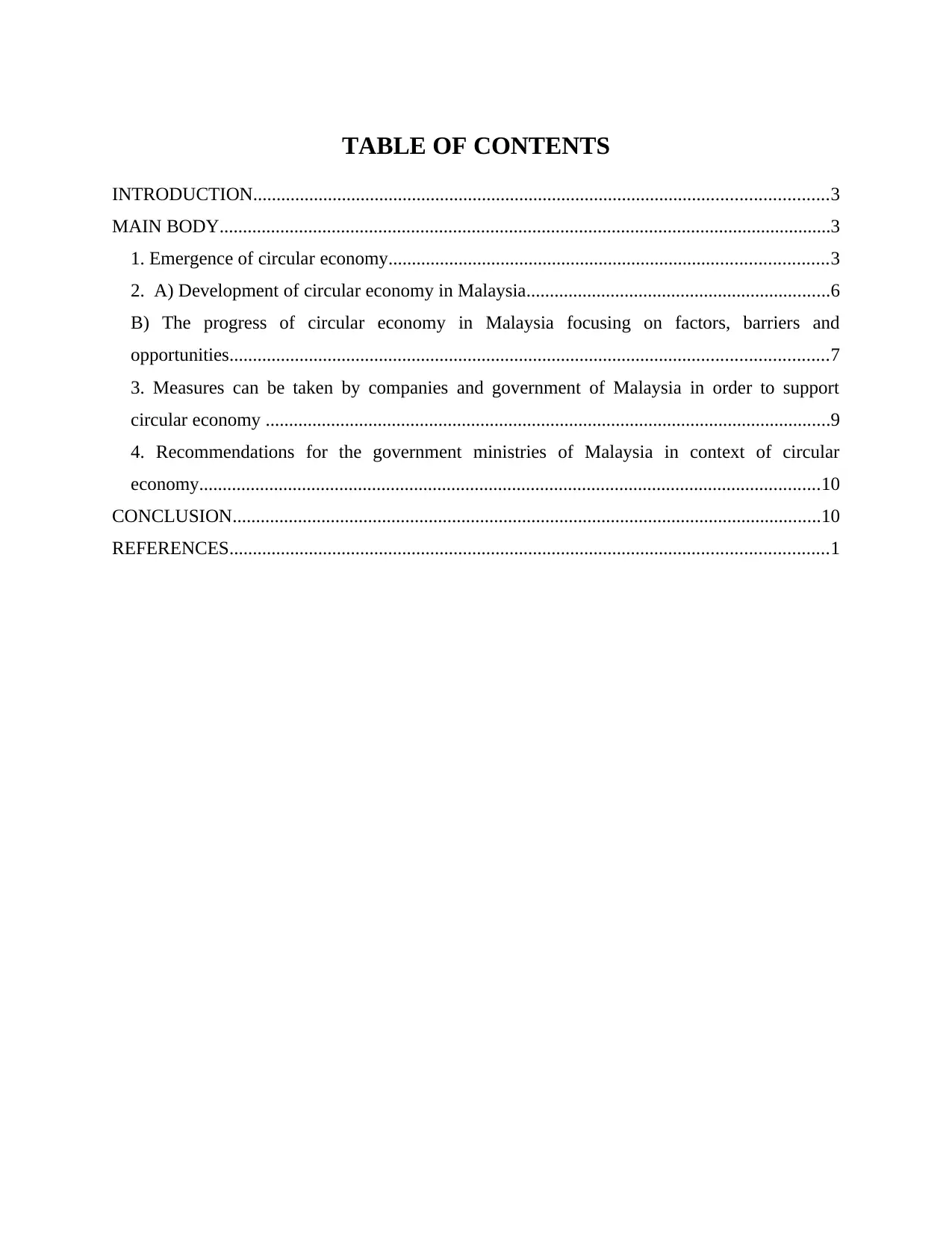
TABLE OF CONTENTS
INTRODUCTION...........................................................................................................................3
MAIN BODY...................................................................................................................................3
1. Emergence of circular economy..............................................................................................3
2. A) Development of circular economy in Malaysia.................................................................6
B) The progress of circular economy in Malaysia focusing on factors, barriers and
opportunities................................................................................................................................7
3. Measures can be taken by companies and government of Malaysia in order to support
circular economy .........................................................................................................................9
4. Recommendations for the government ministries of Malaysia in context of circular
economy.....................................................................................................................................10
CONCLUSION..............................................................................................................................10
REFERENCES................................................................................................................................1
INTRODUCTION...........................................................................................................................3
MAIN BODY...................................................................................................................................3
1. Emergence of circular economy..............................................................................................3
2. A) Development of circular economy in Malaysia.................................................................6
B) The progress of circular economy in Malaysia focusing on factors, barriers and
opportunities................................................................................................................................7
3. Measures can be taken by companies and government of Malaysia in order to support
circular economy .........................................................................................................................9
4. Recommendations for the government ministries of Malaysia in context of circular
economy.....................................................................................................................................10
CONCLUSION..............................................................................................................................10
REFERENCES................................................................................................................................1
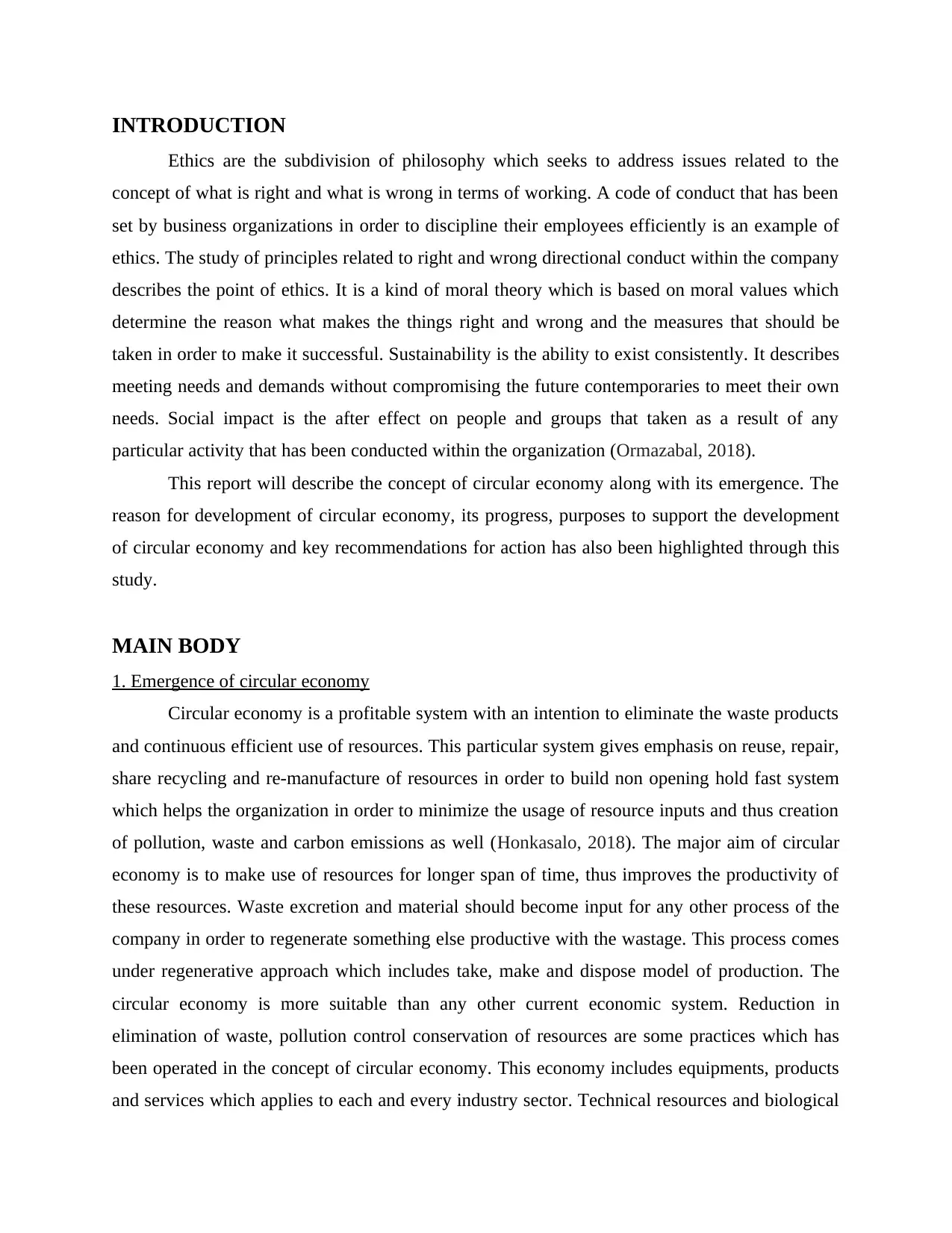
INTRODUCTION
Ethics are the subdivision of philosophy which seeks to address issues related to the
concept of what is right and what is wrong in terms of working. A code of conduct that has been
set by business organizations in order to discipline their employees efficiently is an example of
ethics. The study of principles related to right and wrong directional conduct within the company
describes the point of ethics. It is a kind of moral theory which is based on moral values which
determine the reason what makes the things right and wrong and the measures that should be
taken in order to make it successful. Sustainability is the ability to exist consistently. It describes
meeting needs and demands without compromising the future contemporaries to meet their own
needs. Social impact is the after effect on people and groups that taken as a result of any
particular activity that has been conducted within the organization (Ormazabal, 2018).
This report will describe the concept of circular economy along with its emergence. The
reason for development of circular economy, its progress, purposes to support the development
of circular economy and key recommendations for action has also been highlighted through this
study.
MAIN BODY
1. Emergence of circular economy
Circular economy is a profitable system with an intention to eliminate the waste products
and continuous efficient use of resources. This particular system gives emphasis on reuse, repair,
share recycling and re-manufacture of resources in order to build non opening hold fast system
which helps the organization in order to minimize the usage of resource inputs and thus creation
of pollution, waste and carbon emissions as well (Honkasalo, 2018). The major aim of circular
economy is to make use of resources for longer span of time, thus improves the productivity of
these resources. Waste excretion and material should become input for any other process of the
company in order to regenerate something else productive with the wastage. This process comes
under regenerative approach which includes take, make and dispose model of production. The
circular economy is more suitable than any other current economic system. Reduction in
elimination of waste, pollution control conservation of resources are some practices which has
been operated in the concept of circular economy. This economy includes equipments, products
and services which applies to each and every industry sector. Technical resources and biological
Ethics are the subdivision of philosophy which seeks to address issues related to the
concept of what is right and what is wrong in terms of working. A code of conduct that has been
set by business organizations in order to discipline their employees efficiently is an example of
ethics. The study of principles related to right and wrong directional conduct within the company
describes the point of ethics. It is a kind of moral theory which is based on moral values which
determine the reason what makes the things right and wrong and the measures that should be
taken in order to make it successful. Sustainability is the ability to exist consistently. It describes
meeting needs and demands without compromising the future contemporaries to meet their own
needs. Social impact is the after effect on people and groups that taken as a result of any
particular activity that has been conducted within the organization (Ormazabal, 2018).
This report will describe the concept of circular economy along with its emergence. The
reason for development of circular economy, its progress, purposes to support the development
of circular economy and key recommendations for action has also been highlighted through this
study.
MAIN BODY
1. Emergence of circular economy
Circular economy is a profitable system with an intention to eliminate the waste products
and continuous efficient use of resources. This particular system gives emphasis on reuse, repair,
share recycling and re-manufacture of resources in order to build non opening hold fast system
which helps the organization in order to minimize the usage of resource inputs and thus creation
of pollution, waste and carbon emissions as well (Honkasalo, 2018). The major aim of circular
economy is to make use of resources for longer span of time, thus improves the productivity of
these resources. Waste excretion and material should become input for any other process of the
company in order to regenerate something else productive with the wastage. This process comes
under regenerative approach which includes take, make and dispose model of production. The
circular economy is more suitable than any other current economic system. Reduction in
elimination of waste, pollution control conservation of resources are some practices which has
been operated in the concept of circular economy. This economy includes equipments, products
and services which applies to each and every industry sector. Technical resources and biological
⊘ This is a preview!⊘
Do you want full access?
Subscribe today to unlock all pages.

Trusted by 1+ million students worldwide
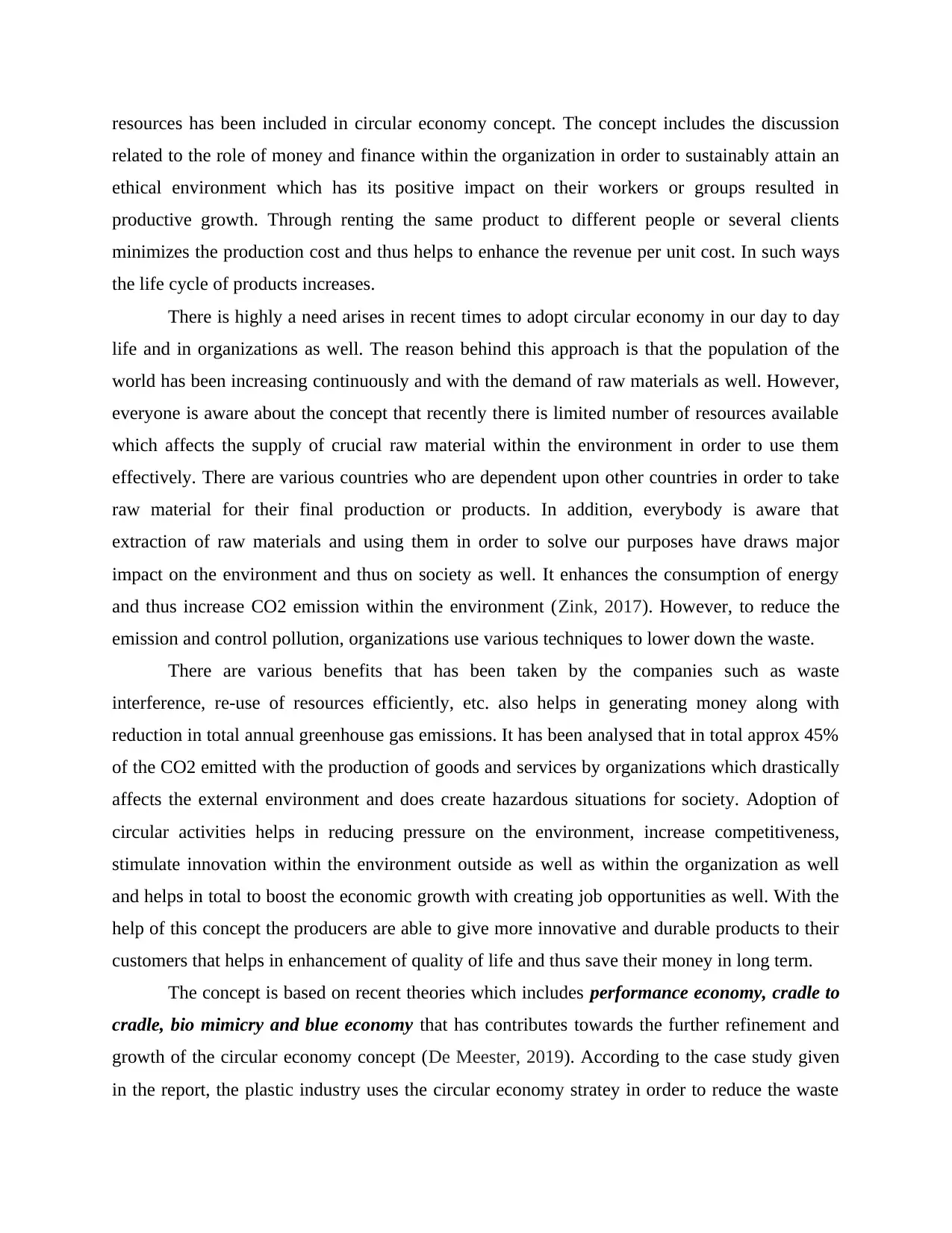
resources has been included in circular economy concept. The concept includes the discussion
related to the role of money and finance within the organization in order to sustainably attain an
ethical environment which has its positive impact on their workers or groups resulted in
productive growth. Through renting the same product to different people or several clients
minimizes the production cost and thus helps to enhance the revenue per unit cost. In such ways
the life cycle of products increases.
There is highly a need arises in recent times to adopt circular economy in our day to day
life and in organizations as well. The reason behind this approach is that the population of the
world has been increasing continuously and with the demand of raw materials as well. However,
everyone is aware about the concept that recently there is limited number of resources available
which affects the supply of crucial raw material within the environment in order to use them
effectively. There are various countries who are dependent upon other countries in order to take
raw material for their final production or products. In addition, everybody is aware that
extraction of raw materials and using them in order to solve our purposes have draws major
impact on the environment and thus on society as well. It enhances the consumption of energy
and thus increase CO2 emission within the environment (Zink, 2017). However, to reduce the
emission and control pollution, organizations use various techniques to lower down the waste.
There are various benefits that has been taken by the companies such as waste
interference, re-use of resources efficiently, etc. also helps in generating money along with
reduction in total annual greenhouse gas emissions. It has been analysed that in total approx 45%
of the CO2 emitted with the production of goods and services by organizations which drastically
affects the external environment and does create hazardous situations for society. Adoption of
circular activities helps in reducing pressure on the environment, increase competitiveness,
stimulate innovation within the environment outside as well as within the organization as well
and helps in total to boost the economic growth with creating job opportunities as well. With the
help of this concept the producers are able to give more innovative and durable products to their
customers that helps in enhancement of quality of life and thus save their money in long term.
The concept is based on recent theories which includes performance economy, cradle to
cradle, bio mimicry and blue economy that has contributes towards the further refinement and
growth of the circular economy concept (De Meester, 2019). According to the case study given
in the report, the plastic industry uses the circular economy stratey in order to reduce the waste
related to the role of money and finance within the organization in order to sustainably attain an
ethical environment which has its positive impact on their workers or groups resulted in
productive growth. Through renting the same product to different people or several clients
minimizes the production cost and thus helps to enhance the revenue per unit cost. In such ways
the life cycle of products increases.
There is highly a need arises in recent times to adopt circular economy in our day to day
life and in organizations as well. The reason behind this approach is that the population of the
world has been increasing continuously and with the demand of raw materials as well. However,
everyone is aware about the concept that recently there is limited number of resources available
which affects the supply of crucial raw material within the environment in order to use them
effectively. There are various countries who are dependent upon other countries in order to take
raw material for their final production or products. In addition, everybody is aware that
extraction of raw materials and using them in order to solve our purposes have draws major
impact on the environment and thus on society as well. It enhances the consumption of energy
and thus increase CO2 emission within the environment (Zink, 2017). However, to reduce the
emission and control pollution, organizations use various techniques to lower down the waste.
There are various benefits that has been taken by the companies such as waste
interference, re-use of resources efficiently, etc. also helps in generating money along with
reduction in total annual greenhouse gas emissions. It has been analysed that in total approx 45%
of the CO2 emitted with the production of goods and services by organizations which drastically
affects the external environment and does create hazardous situations for society. Adoption of
circular activities helps in reducing pressure on the environment, increase competitiveness,
stimulate innovation within the environment outside as well as within the organization as well
and helps in total to boost the economic growth with creating job opportunities as well. With the
help of this concept the producers are able to give more innovative and durable products to their
customers that helps in enhancement of quality of life and thus save their money in long term.
The concept is based on recent theories which includes performance economy, cradle to
cradle, bio mimicry and blue economy that has contributes towards the further refinement and
growth of the circular economy concept (De Meester, 2019). According to the case study given
in the report, the plastic industry uses the circular economy stratey in order to reduce the waste
Paraphrase This Document
Need a fresh take? Get an instant paraphrase of this document with our AI Paraphraser
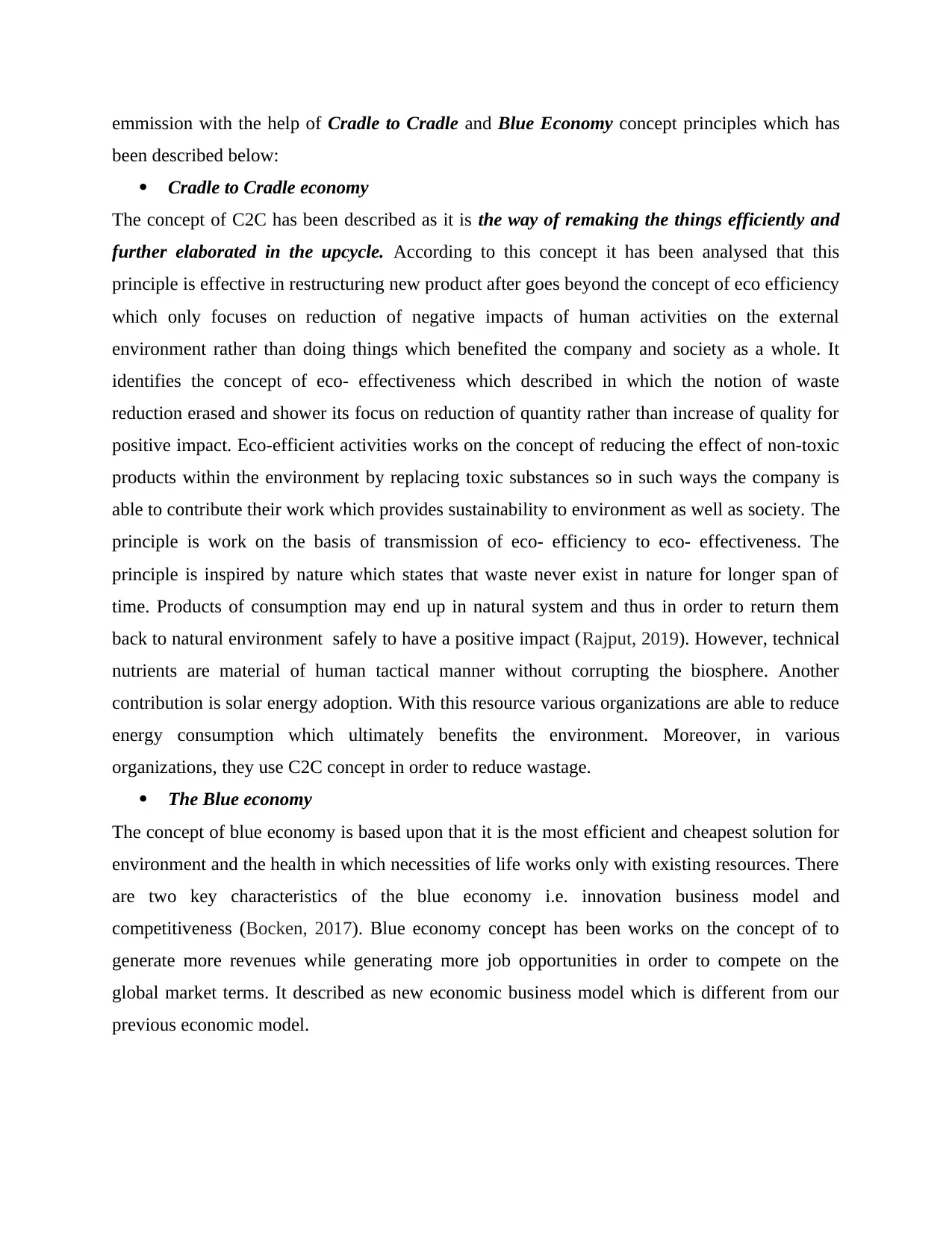
emmission with the help of Cradle to Cradle and Blue Economy concept principles which has
been described below:
Cradle to Cradle economy
The concept of C2C has been described as it is the way of remaking the things efficiently and
further elaborated in the upcycle. According to this concept it has been analysed that this
principle is effective in restructuring new product after goes beyond the concept of eco efficiency
which only focuses on reduction of negative impacts of human activities on the external
environment rather than doing things which benefited the company and society as a whole. It
identifies the concept of eco- effectiveness which described in which the notion of waste
reduction erased and shower its focus on reduction of quantity rather than increase of quality for
positive impact. Eco-efficient activities works on the concept of reducing the effect of non-toxic
products within the environment by replacing toxic substances so in such ways the company is
able to contribute their work which provides sustainability to environment as well as society. The
principle is work on the basis of transmission of eco- efficiency to eco- effectiveness. The
principle is inspired by nature which states that waste never exist in nature for longer span of
time. Products of consumption may end up in natural system and thus in order to return them
back to natural environment safely to have a positive impact (Rajput, 2019). However, technical
nutrients are material of human tactical manner without corrupting the biosphere. Another
contribution is solar energy adoption. With this resource various organizations are able to reduce
energy consumption which ultimately benefits the environment. Moreover, in various
organizations, they use C2C concept in order to reduce wastage.
The Blue economy
The concept of blue economy is based upon that it is the most efficient and cheapest solution for
environment and the health in which necessities of life works only with existing resources. There
are two key characteristics of the blue economy i.e. innovation business model and
competitiveness (Bocken, 2017). Blue economy concept has been works on the concept of to
generate more revenues while generating more job opportunities in order to compete on the
global market terms. It described as new economic business model which is different from our
previous economic model.
been described below:
Cradle to Cradle economy
The concept of C2C has been described as it is the way of remaking the things efficiently and
further elaborated in the upcycle. According to this concept it has been analysed that this
principle is effective in restructuring new product after goes beyond the concept of eco efficiency
which only focuses on reduction of negative impacts of human activities on the external
environment rather than doing things which benefited the company and society as a whole. It
identifies the concept of eco- effectiveness which described in which the notion of waste
reduction erased and shower its focus on reduction of quantity rather than increase of quality for
positive impact. Eco-efficient activities works on the concept of reducing the effect of non-toxic
products within the environment by replacing toxic substances so in such ways the company is
able to contribute their work which provides sustainability to environment as well as society. The
principle is work on the basis of transmission of eco- efficiency to eco- effectiveness. The
principle is inspired by nature which states that waste never exist in nature for longer span of
time. Products of consumption may end up in natural system and thus in order to return them
back to natural environment safely to have a positive impact (Rajput, 2019). However, technical
nutrients are material of human tactical manner without corrupting the biosphere. Another
contribution is solar energy adoption. With this resource various organizations are able to reduce
energy consumption which ultimately benefits the environment. Moreover, in various
organizations, they use C2C concept in order to reduce wastage.
The Blue economy
The concept of blue economy is based upon that it is the most efficient and cheapest solution for
environment and the health in which necessities of life works only with existing resources. There
are two key characteristics of the blue economy i.e. innovation business model and
competitiveness (Bocken, 2017). Blue economy concept has been works on the concept of to
generate more revenues while generating more job opportunities in order to compete on the
global market terms. It described as new economic business model which is different from our
previous economic model.
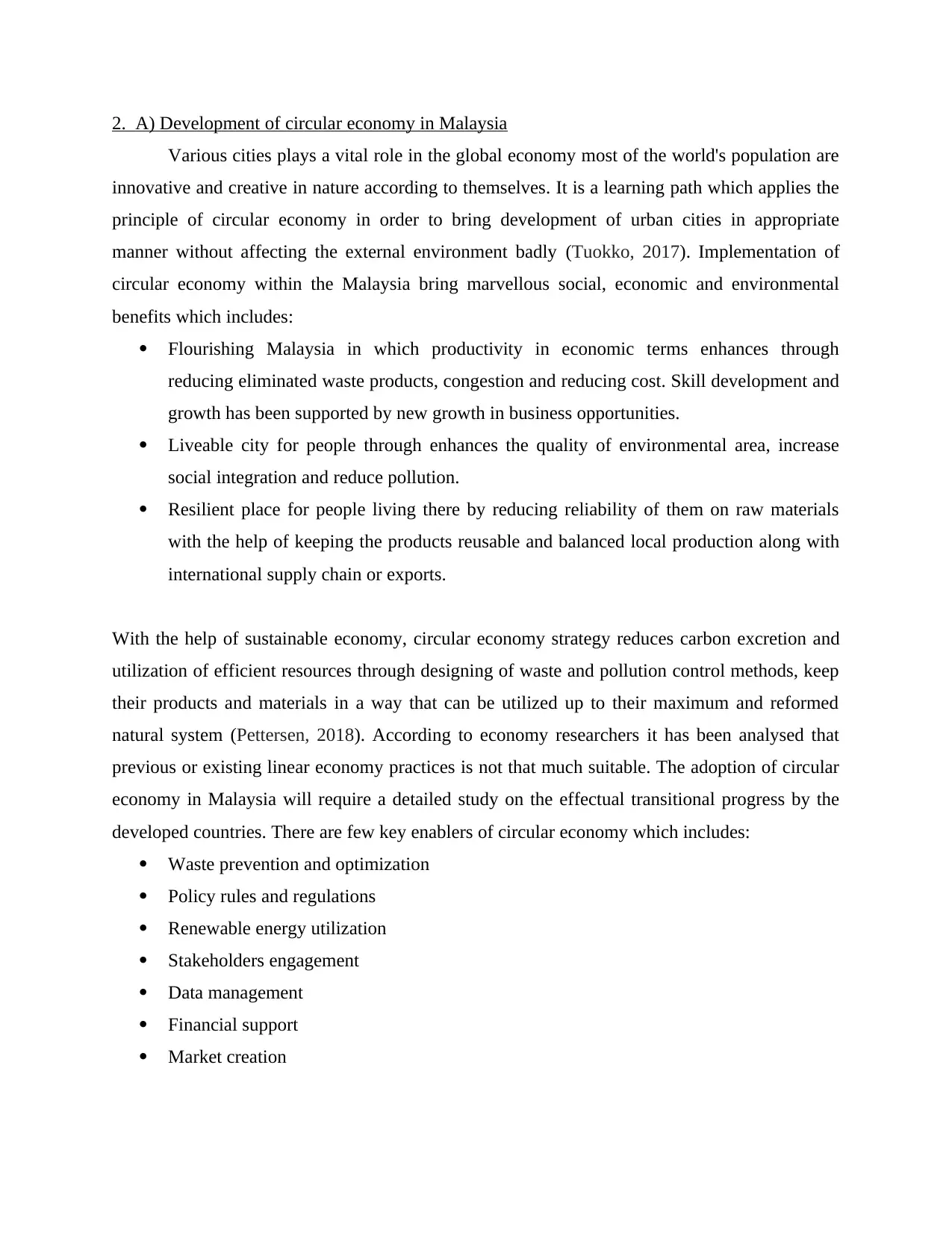
2. A) Development of circular economy in Malaysia
Various cities plays a vital role in the global economy most of the world's population are
innovative and creative in nature according to themselves. It is a learning path which applies the
principle of circular economy in order to bring development of urban cities in appropriate
manner without affecting the external environment badly (Tuokko, 2017). Implementation of
circular economy within the Malaysia bring marvellous social, economic and environmental
benefits which includes:
Flourishing Malaysia in which productivity in economic terms enhances through
reducing eliminated waste products, congestion and reducing cost. Skill development and
growth has been supported by new growth in business opportunities.
Liveable city for people through enhances the quality of environmental area, increase
social integration and reduce pollution.
Resilient place for people living there by reducing reliability of them on raw materials
with the help of keeping the products reusable and balanced local production along with
international supply chain or exports.
With the help of sustainable economy, circular economy strategy reduces carbon excretion and
utilization of efficient resources through designing of waste and pollution control methods, keep
their products and materials in a way that can be utilized up to their maximum and reformed
natural system (Pettersen, 2018). According to economy researchers it has been analysed that
previous or existing linear economy practices is not that much suitable. The adoption of circular
economy in Malaysia will require a detailed study on the effectual transitional progress by the
developed countries. There are few key enablers of circular economy which includes:
Waste prevention and optimization
Policy rules and regulations
Renewable energy utilization
Stakeholders engagement
Data management
Financial support
Market creation
Various cities plays a vital role in the global economy most of the world's population are
innovative and creative in nature according to themselves. It is a learning path which applies the
principle of circular economy in order to bring development of urban cities in appropriate
manner without affecting the external environment badly (Tuokko, 2017). Implementation of
circular economy within the Malaysia bring marvellous social, economic and environmental
benefits which includes:
Flourishing Malaysia in which productivity in economic terms enhances through
reducing eliminated waste products, congestion and reducing cost. Skill development and
growth has been supported by new growth in business opportunities.
Liveable city for people through enhances the quality of environmental area, increase
social integration and reduce pollution.
Resilient place for people living there by reducing reliability of them on raw materials
with the help of keeping the products reusable and balanced local production along with
international supply chain or exports.
With the help of sustainable economy, circular economy strategy reduces carbon excretion and
utilization of efficient resources through designing of waste and pollution control methods, keep
their products and materials in a way that can be utilized up to their maximum and reformed
natural system (Pettersen, 2018). According to economy researchers it has been analysed that
previous or existing linear economy practices is not that much suitable. The adoption of circular
economy in Malaysia will require a detailed study on the effectual transitional progress by the
developed countries. There are few key enablers of circular economy which includes:
Waste prevention and optimization
Policy rules and regulations
Renewable energy utilization
Stakeholders engagement
Data management
Financial support
Market creation
⊘ This is a preview!⊘
Do you want full access?
Subscribe today to unlock all pages.

Trusted by 1+ million students worldwide
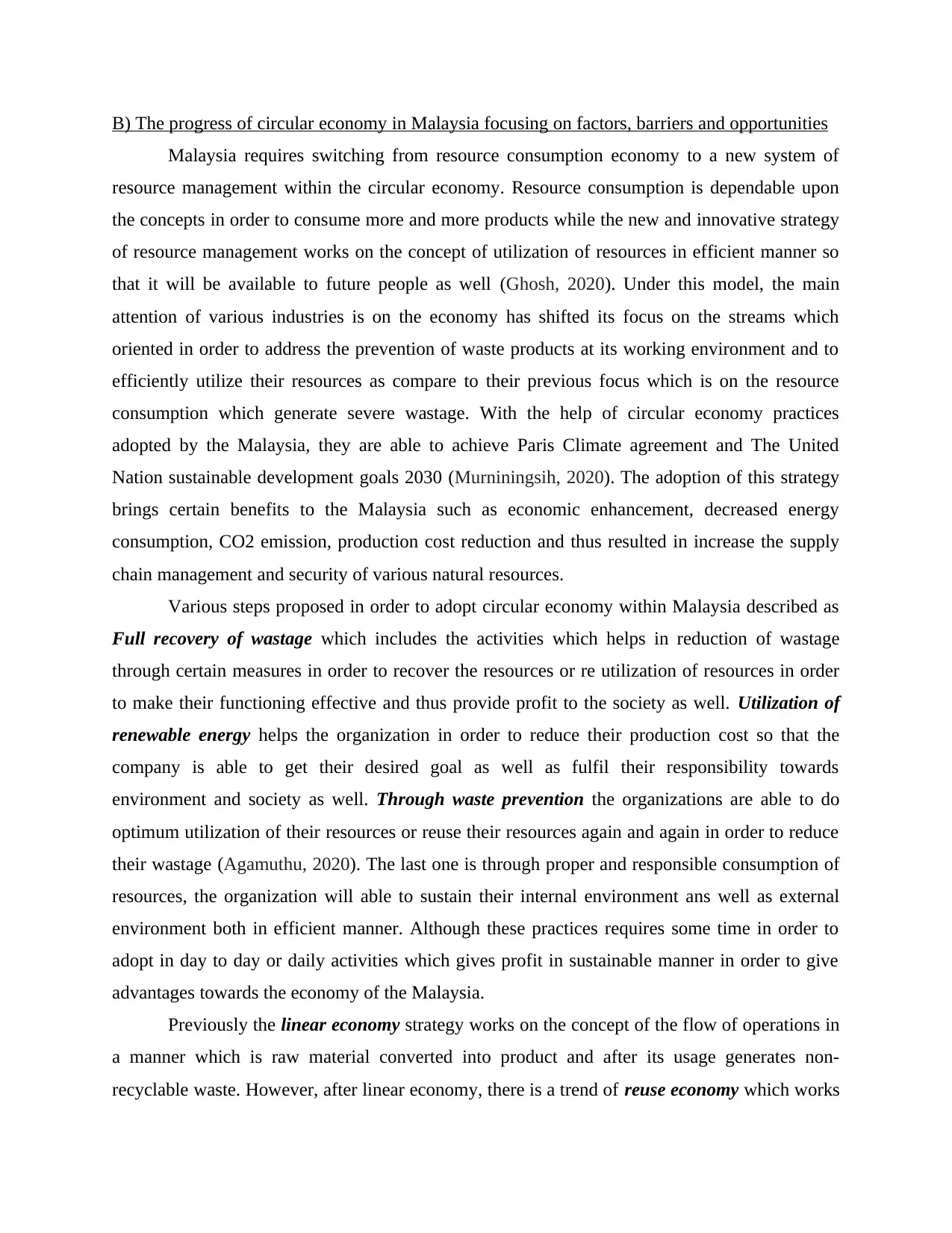
B) The progress of circular economy in Malaysia focusing on factors, barriers and opportunities
Malaysia requires switching from resource consumption economy to a new system of
resource management within the circular economy. Resource consumption is dependable upon
the concepts in order to consume more and more products while the new and innovative strategy
of resource management works on the concept of utilization of resources in efficient manner so
that it will be available to future people as well (Ghosh, 2020). Under this model, the main
attention of various industries is on the economy has shifted its focus on the streams which
oriented in order to address the prevention of waste products at its working environment and to
efficiently utilize their resources as compare to their previous focus which is on the resource
consumption which generate severe wastage. With the help of circular economy practices
adopted by the Malaysia, they are able to achieve Paris Climate agreement and The United
Nation sustainable development goals 2030 (Murniningsih, 2020). The adoption of this strategy
brings certain benefits to the Malaysia such as economic enhancement, decreased energy
consumption, CO2 emission, production cost reduction and thus resulted in increase the supply
chain management and security of various natural resources.
Various steps proposed in order to adopt circular economy within Malaysia described as
Full recovery of wastage which includes the activities which helps in reduction of wastage
through certain measures in order to recover the resources or re utilization of resources in order
to make their functioning effective and thus provide profit to the society as well. Utilization of
renewable energy helps the organization in order to reduce their production cost so that the
company is able to get their desired goal as well as fulfil their responsibility towards
environment and society as well. Through waste prevention the organizations are able to do
optimum utilization of their resources or reuse their resources again and again in order to reduce
their wastage (Agamuthu, 2020). The last one is through proper and responsible consumption of
resources, the organization will able to sustain their internal environment ans well as external
environment both in efficient manner. Although these practices requires some time in order to
adopt in day to day or daily activities which gives profit in sustainable manner in order to give
advantages towards the economy of the Malaysia.
Previously the linear economy strategy works on the concept of the flow of operations in
a manner which is raw material converted into product and after its usage generates non-
recyclable waste. However, after linear economy, there is a trend of reuse economy which works
Malaysia requires switching from resource consumption economy to a new system of
resource management within the circular economy. Resource consumption is dependable upon
the concepts in order to consume more and more products while the new and innovative strategy
of resource management works on the concept of utilization of resources in efficient manner so
that it will be available to future people as well (Ghosh, 2020). Under this model, the main
attention of various industries is on the economy has shifted its focus on the streams which
oriented in order to address the prevention of waste products at its working environment and to
efficiently utilize their resources as compare to their previous focus which is on the resource
consumption which generate severe wastage. With the help of circular economy practices
adopted by the Malaysia, they are able to achieve Paris Climate agreement and The United
Nation sustainable development goals 2030 (Murniningsih, 2020). The adoption of this strategy
brings certain benefits to the Malaysia such as economic enhancement, decreased energy
consumption, CO2 emission, production cost reduction and thus resulted in increase the supply
chain management and security of various natural resources.
Various steps proposed in order to adopt circular economy within Malaysia described as
Full recovery of wastage which includes the activities which helps in reduction of wastage
through certain measures in order to recover the resources or re utilization of resources in order
to make their functioning effective and thus provide profit to the society as well. Utilization of
renewable energy helps the organization in order to reduce their production cost so that the
company is able to get their desired goal as well as fulfil their responsibility towards
environment and society as well. Through waste prevention the organizations are able to do
optimum utilization of their resources or reuse their resources again and again in order to reduce
their wastage (Agamuthu, 2020). The last one is through proper and responsible consumption of
resources, the organization will able to sustain their internal environment ans well as external
environment both in efficient manner. Although these practices requires some time in order to
adopt in day to day or daily activities which gives profit in sustainable manner in order to give
advantages towards the economy of the Malaysia.
Previously the linear economy strategy works on the concept of the flow of operations in
a manner which is raw material converted into product and after its usage generates non-
recyclable waste. However, after linear economy, there is a trend of reuse economy which works
Paraphrase This Document
Need a fresh take? Get an instant paraphrase of this document with our AI Paraphraser
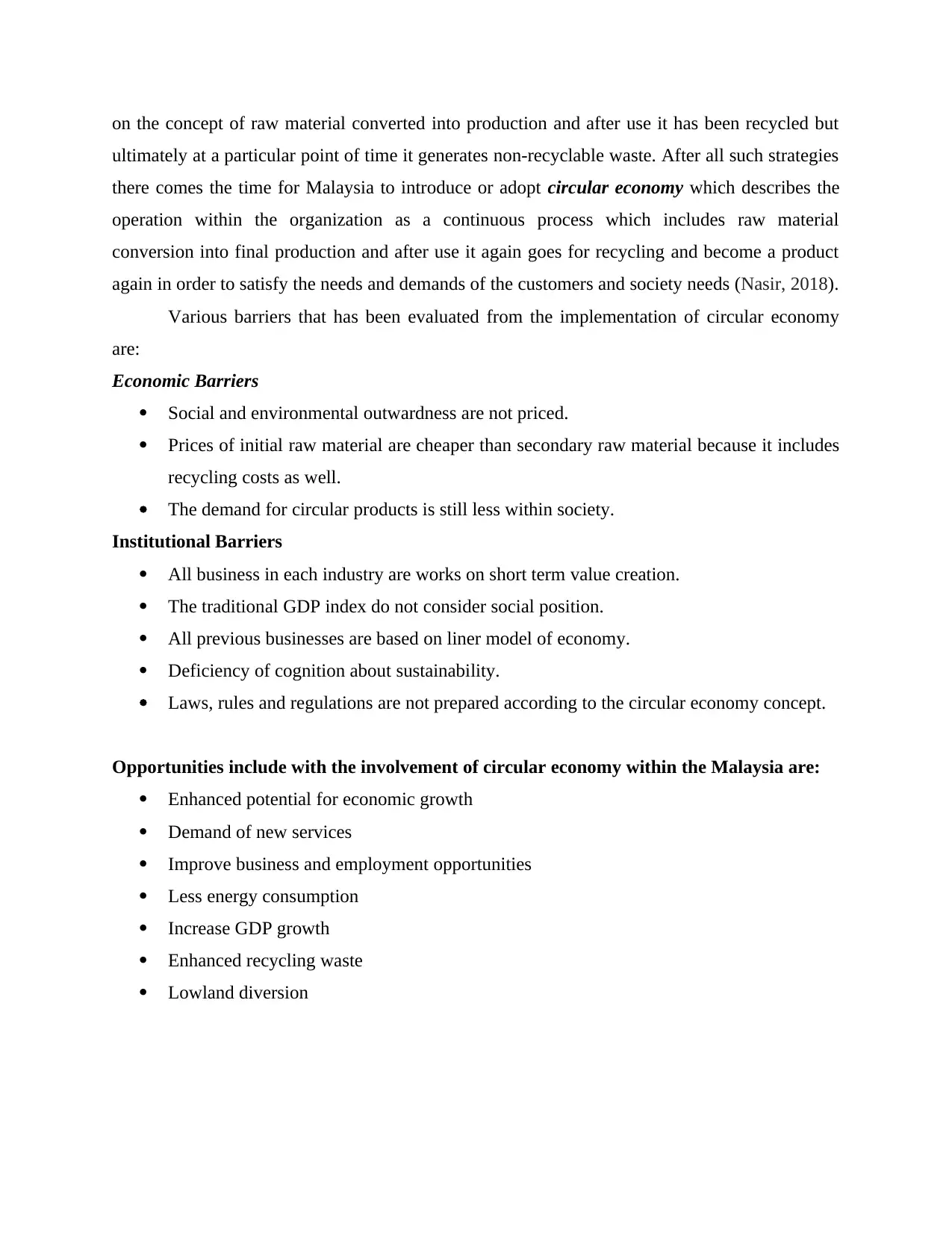
on the concept of raw material converted into production and after use it has been recycled but
ultimately at a particular point of time it generates non-recyclable waste. After all such strategies
there comes the time for Malaysia to introduce or adopt circular economy which describes the
operation within the organization as a continuous process which includes raw material
conversion into final production and after use it again goes for recycling and become a product
again in order to satisfy the needs and demands of the customers and society needs (Nasir, 2018).
Various barriers that has been evaluated from the implementation of circular economy
are:
Economic Barriers
Social and environmental outwardness are not priced.
Prices of initial raw material are cheaper than secondary raw material because it includes
recycling costs as well.
The demand for circular products is still less within society.
Institutional Barriers
All business in each industry are works on short term value creation.
The traditional GDP index do not consider social position.
All previous businesses are based on liner model of economy.
Deficiency of cognition about sustainability.
Laws, rules and regulations are not prepared according to the circular economy concept.
Opportunities include with the involvement of circular economy within the Malaysia are:
Enhanced potential for economic growth
Demand of new services
Improve business and employment opportunities
Less energy consumption
Increase GDP growth
Enhanced recycling waste
Lowland diversion
ultimately at a particular point of time it generates non-recyclable waste. After all such strategies
there comes the time for Malaysia to introduce or adopt circular economy which describes the
operation within the organization as a continuous process which includes raw material
conversion into final production and after use it again goes for recycling and become a product
again in order to satisfy the needs and demands of the customers and society needs (Nasir, 2018).
Various barriers that has been evaluated from the implementation of circular economy
are:
Economic Barriers
Social and environmental outwardness are not priced.
Prices of initial raw material are cheaper than secondary raw material because it includes
recycling costs as well.
The demand for circular products is still less within society.
Institutional Barriers
All business in each industry are works on short term value creation.
The traditional GDP index do not consider social position.
All previous businesses are based on liner model of economy.
Deficiency of cognition about sustainability.
Laws, rules and regulations are not prepared according to the circular economy concept.
Opportunities include with the involvement of circular economy within the Malaysia are:
Enhanced potential for economic growth
Demand of new services
Improve business and employment opportunities
Less energy consumption
Increase GDP growth
Enhanced recycling waste
Lowland diversion
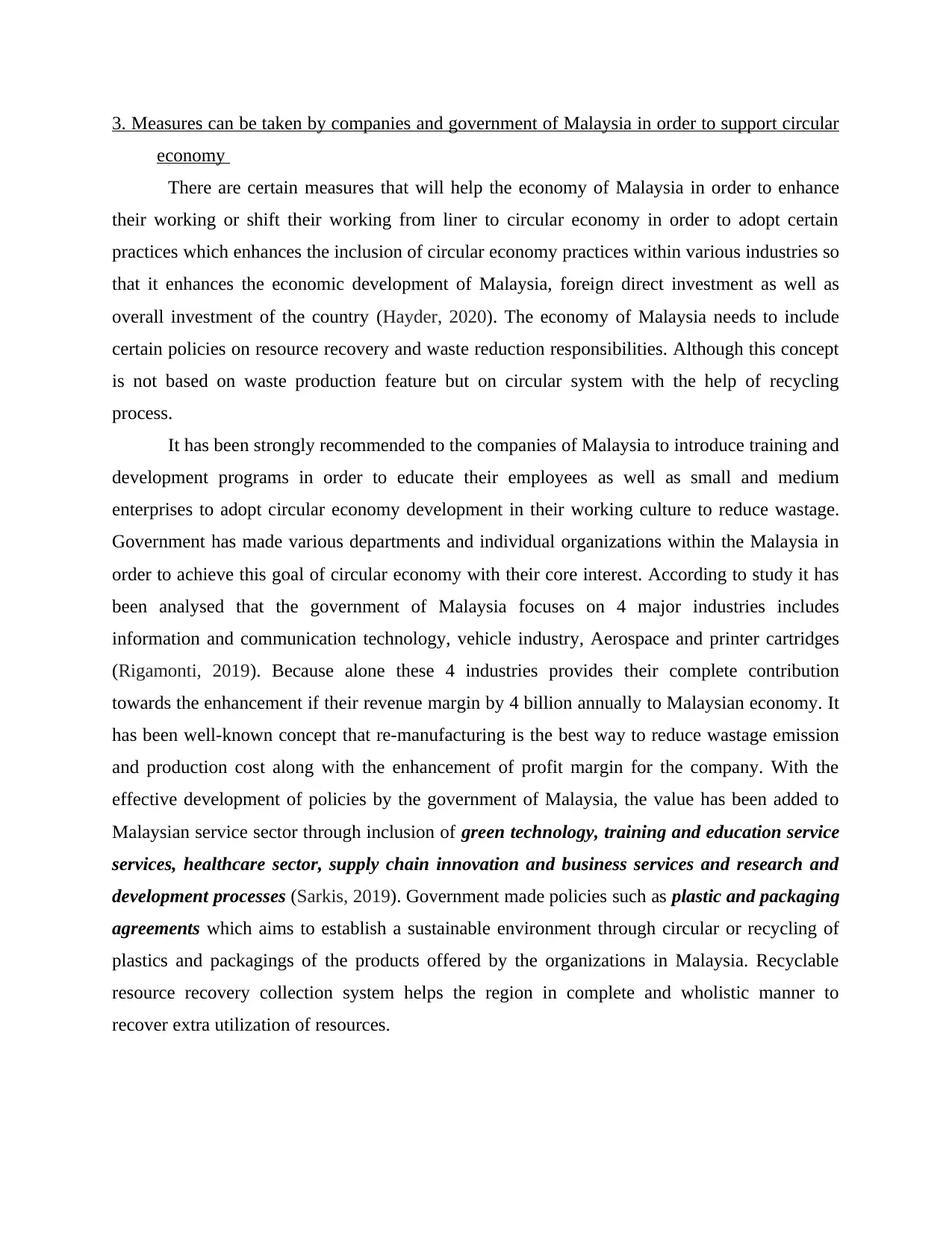
3. Measures can be taken by companies and government of Malaysia in order to support circular
economy
There are certain measures that will help the economy of Malaysia in order to enhance
their working or shift their working from liner to circular economy in order to adopt certain
practices which enhances the inclusion of circular economy practices within various industries so
that it enhances the economic development of Malaysia, foreign direct investment as well as
overall investment of the country (Hayder, 2020). The economy of Malaysia needs to include
certain policies on resource recovery and waste reduction responsibilities. Although this concept
is not based on waste production feature but on circular system with the help of recycling
process.
It has been strongly recommended to the companies of Malaysia to introduce training and
development programs in order to educate their employees as well as small and medium
enterprises to adopt circular economy development in their working culture to reduce wastage.
Government has made various departments and individual organizations within the Malaysia in
order to achieve this goal of circular economy with their core interest. According to study it has
been analysed that the government of Malaysia focuses on 4 major industries includes
information and communication technology, vehicle industry, Aerospace and printer cartridges
(Rigamonti, 2019). Because alone these 4 industries provides their complete contribution
towards the enhancement if their revenue margin by 4 billion annually to Malaysian economy. It
has been well-known concept that re-manufacturing is the best way to reduce wastage emission
and production cost along with the enhancement of profit margin for the company. With the
effective development of policies by the government of Malaysia, the value has been added to
Malaysian service sector through inclusion of green technology, training and education service
services, healthcare sector, supply chain innovation and business services and research and
development processes (Sarkis, 2019). Government made policies such as plastic and packaging
agreements which aims to establish a sustainable environment through circular or recycling of
plastics and packagings of the products offered by the organizations in Malaysia. Recyclable
resource recovery collection system helps the region in complete and wholistic manner to
recover extra utilization of resources.
economy
There are certain measures that will help the economy of Malaysia in order to enhance
their working or shift their working from liner to circular economy in order to adopt certain
practices which enhances the inclusion of circular economy practices within various industries so
that it enhances the economic development of Malaysia, foreign direct investment as well as
overall investment of the country (Hayder, 2020). The economy of Malaysia needs to include
certain policies on resource recovery and waste reduction responsibilities. Although this concept
is not based on waste production feature but on circular system with the help of recycling
process.
It has been strongly recommended to the companies of Malaysia to introduce training and
development programs in order to educate their employees as well as small and medium
enterprises to adopt circular economy development in their working culture to reduce wastage.
Government has made various departments and individual organizations within the Malaysia in
order to achieve this goal of circular economy with their core interest. According to study it has
been analysed that the government of Malaysia focuses on 4 major industries includes
information and communication technology, vehicle industry, Aerospace and printer cartridges
(Rigamonti, 2019). Because alone these 4 industries provides their complete contribution
towards the enhancement if their revenue margin by 4 billion annually to Malaysian economy. It
has been well-known concept that re-manufacturing is the best way to reduce wastage emission
and production cost along with the enhancement of profit margin for the company. With the
effective development of policies by the government of Malaysia, the value has been added to
Malaysian service sector through inclusion of green technology, training and education service
services, healthcare sector, supply chain innovation and business services and research and
development processes (Sarkis, 2019). Government made policies such as plastic and packaging
agreements which aims to establish a sustainable environment through circular or recycling of
plastics and packagings of the products offered by the organizations in Malaysia. Recyclable
resource recovery collection system helps the region in complete and wholistic manner to
recover extra utilization of resources.
⊘ This is a preview!⊘
Do you want full access?
Subscribe today to unlock all pages.

Trusted by 1+ million students worldwide
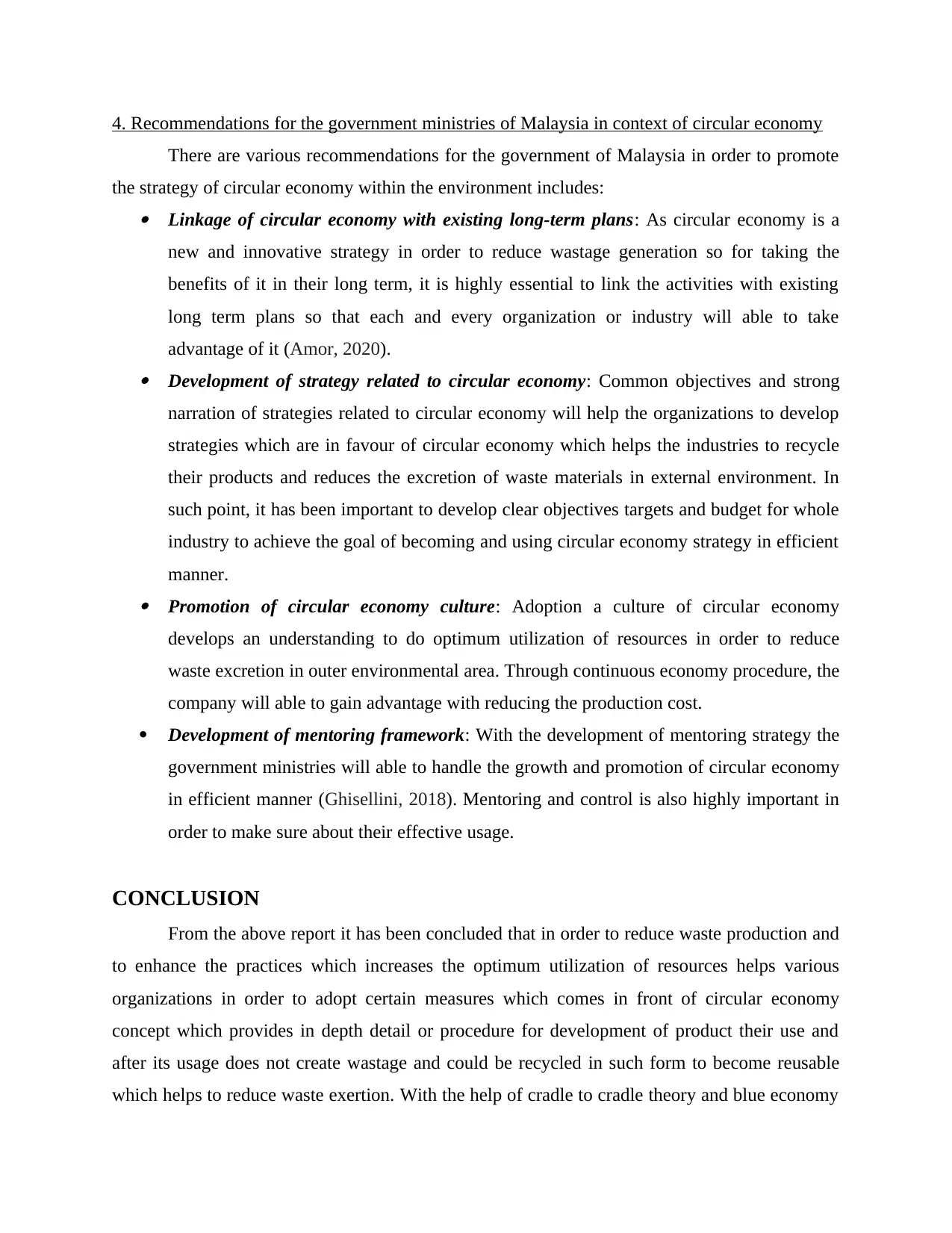
4. Recommendations for the government ministries of Malaysia in context of circular economy
There are various recommendations for the government of Malaysia in order to promote
the strategy of circular economy within the environment includes: Linkage of circular economy with existing long-term plans: As circular economy is a
new and innovative strategy in order to reduce wastage generation so for taking the
benefits of it in their long term, it is highly essential to link the activities with existing
long term plans so that each and every organization or industry will able to take
advantage of it (Amor, 2020). Development of strategy related to circular economy: Common objectives and strong
narration of strategies related to circular economy will help the organizations to develop
strategies which are in favour of circular economy which helps the industries to recycle
their products and reduces the excretion of waste materials in external environment. In
such point, it has been important to develop clear objectives targets and budget for whole
industry to achieve the goal of becoming and using circular economy strategy in efficient
manner. Promotion of circular economy culture: Adoption a culture of circular economy
develops an understanding to do optimum utilization of resources in order to reduce
waste excretion in outer environmental area. Through continuous economy procedure, the
company will able to gain advantage with reducing the production cost.
Development of mentoring framework: With the development of mentoring strategy the
government ministries will able to handle the growth and promotion of circular economy
in efficient manner (Ghisellini, 2018). Mentoring and control is also highly important in
order to make sure about their effective usage.
CONCLUSION
From the above report it has been concluded that in order to reduce waste production and
to enhance the practices which increases the optimum utilization of resources helps various
organizations in order to adopt certain measures which comes in front of circular economy
concept which provides in depth detail or procedure for development of product their use and
after its usage does not create wastage and could be recycled in such form to become reusable
which helps to reduce waste exertion. With the help of cradle to cradle theory and blue economy
There are various recommendations for the government of Malaysia in order to promote
the strategy of circular economy within the environment includes: Linkage of circular economy with existing long-term plans: As circular economy is a
new and innovative strategy in order to reduce wastage generation so for taking the
benefits of it in their long term, it is highly essential to link the activities with existing
long term plans so that each and every organization or industry will able to take
advantage of it (Amor, 2020). Development of strategy related to circular economy: Common objectives and strong
narration of strategies related to circular economy will help the organizations to develop
strategies which are in favour of circular economy which helps the industries to recycle
their products and reduces the excretion of waste materials in external environment. In
such point, it has been important to develop clear objectives targets and budget for whole
industry to achieve the goal of becoming and using circular economy strategy in efficient
manner. Promotion of circular economy culture: Adoption a culture of circular economy
develops an understanding to do optimum utilization of resources in order to reduce
waste excretion in outer environmental area. Through continuous economy procedure, the
company will able to gain advantage with reducing the production cost.
Development of mentoring framework: With the development of mentoring strategy the
government ministries will able to handle the growth and promotion of circular economy
in efficient manner (Ghisellini, 2018). Mentoring and control is also highly important in
order to make sure about their effective usage.
CONCLUSION
From the above report it has been concluded that in order to reduce waste production and
to enhance the practices which increases the optimum utilization of resources helps various
organizations in order to adopt certain measures which comes in front of circular economy
concept which provides in depth detail or procedure for development of product their use and
after its usage does not create wastage and could be recycled in such form to become reusable
which helps to reduce waste exertion. With the help of cradle to cradle theory and blue economy
Paraphrase This Document
Need a fresh take? Get an instant paraphrase of this document with our AI Paraphraser
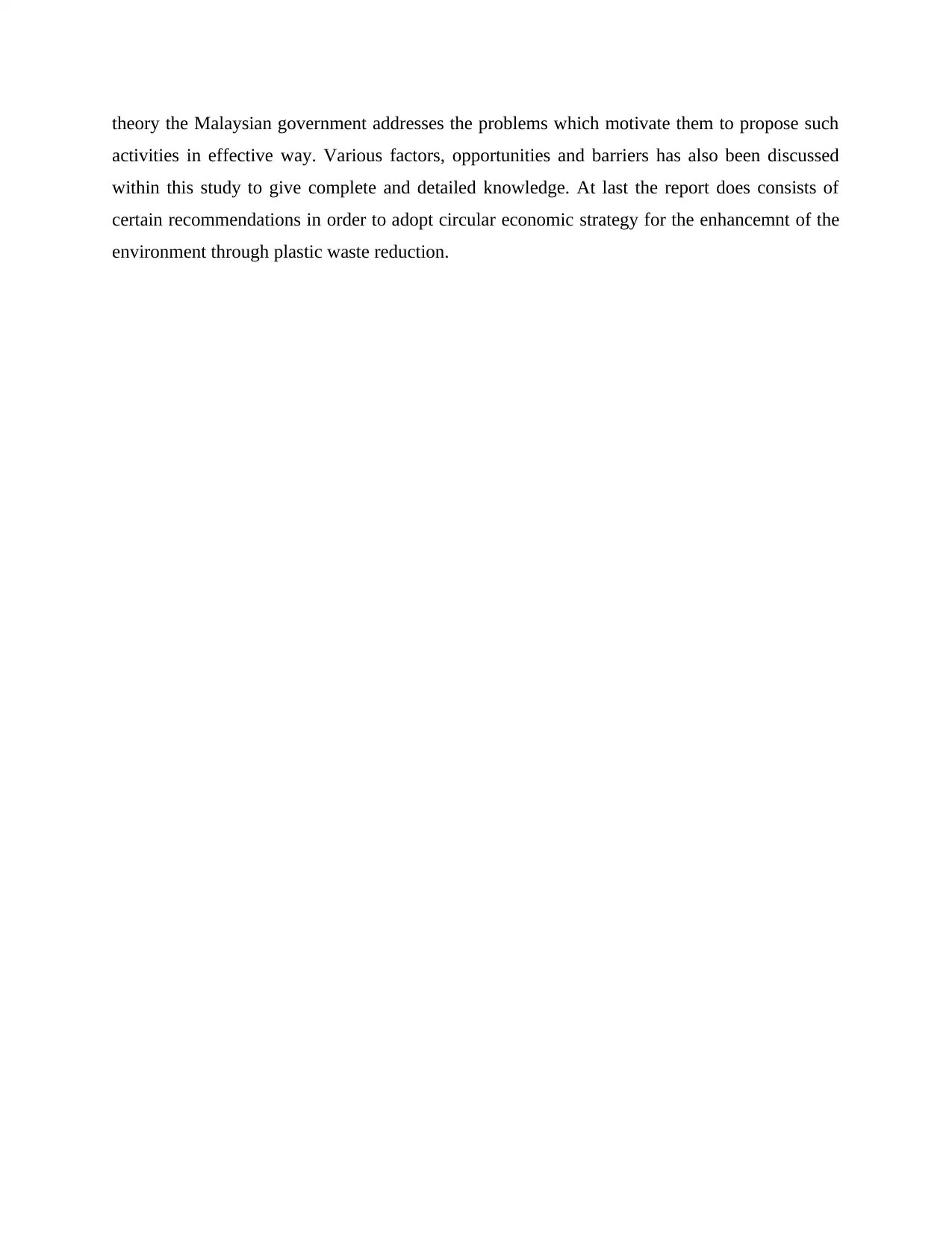
theory the Malaysian government addresses the problems which motivate them to propose such
activities in effective way. Various factors, opportunities and barriers has also been discussed
within this study to give complete and detailed knowledge. At last the report does consists of
certain recommendations in order to adopt circular economic strategy for the enhancemnt of the
environment through plastic waste reduction.
activities in effective way. Various factors, opportunities and barriers has also been discussed
within this study to give complete and detailed knowledge. At last the report does consists of
certain recommendations in order to adopt circular economic strategy for the enhancemnt of the
environment through plastic waste reduction.
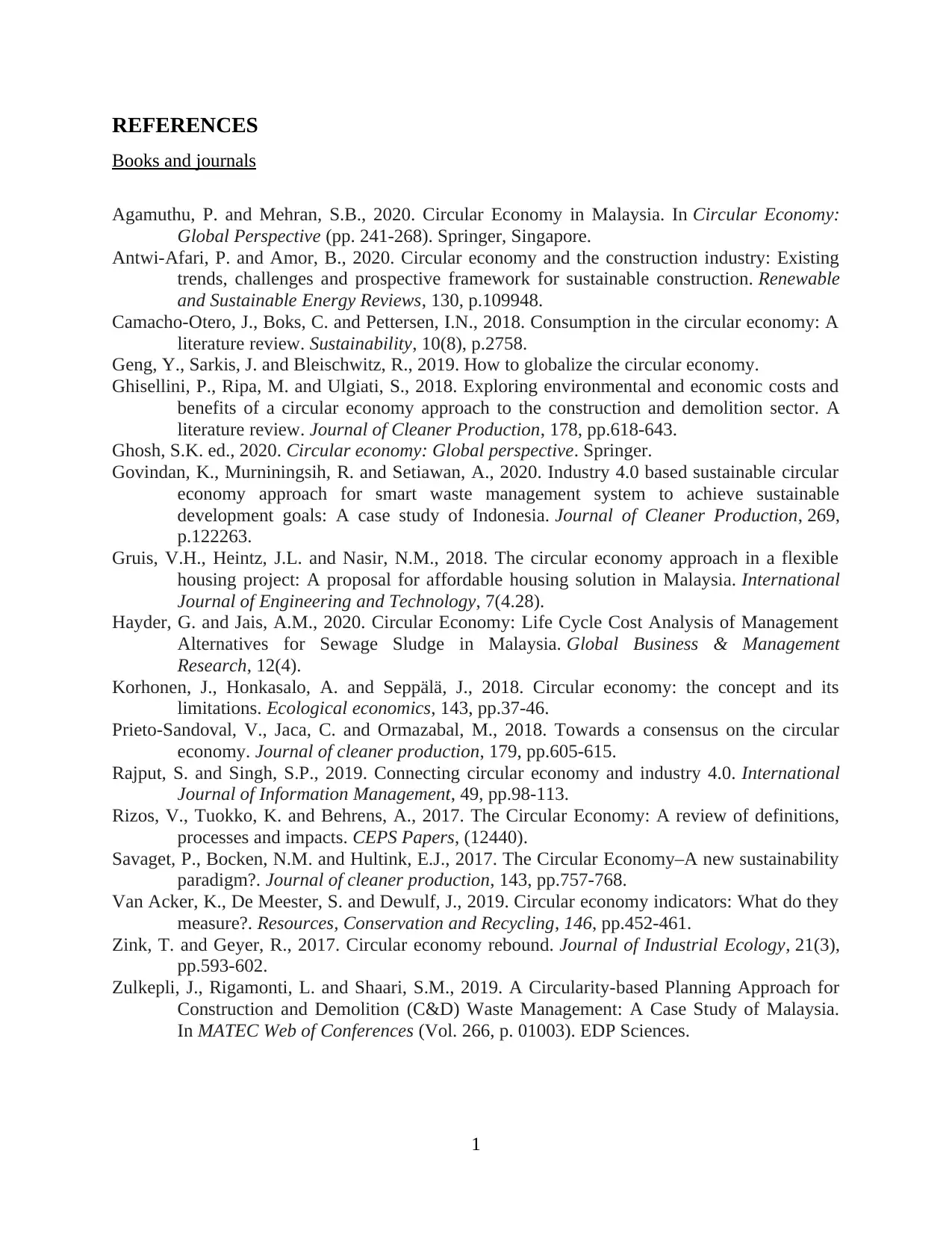
REFERENCES
Books and journals
Agamuthu, P. and Mehran, S.B., 2020. Circular Economy in Malaysia. In Circular Economy:
Global Perspective (pp. 241-268). Springer, Singapore.
Antwi-Afari, P. and Amor, B., 2020. Circular economy and the construction industry: Existing
trends, challenges and prospective framework for sustainable construction. Renewable
and Sustainable Energy Reviews, 130, p.109948.
Camacho-Otero, J., Boks, C. and Pettersen, I.N., 2018. Consumption in the circular economy: A
literature review. Sustainability, 10(8), p.2758.
Geng, Y., Sarkis, J. and Bleischwitz, R., 2019. How to globalize the circular economy.
Ghisellini, P., Ripa, M. and Ulgiati, S., 2018. Exploring environmental and economic costs and
benefits of a circular economy approach to the construction and demolition sector. A
literature review. Journal of Cleaner Production, 178, pp.618-643.
Ghosh, S.K. ed., 2020. Circular economy: Global perspective. Springer.
Govindan, K., Murniningsih, R. and Setiawan, A., 2020. Industry 4.0 based sustainable circular
economy approach for smart waste management system to achieve sustainable
development goals: A case study of Indonesia. Journal of Cleaner Production, 269,
p.122263.
Gruis, V.H., Heintz, J.L. and Nasir, N.M., 2018. The circular economy approach in a flexible
housing project: A proposal for affordable housing solution in Malaysia. International
Journal of Engineering and Technology, 7(4.28).
Hayder, G. and Jais, A.M., 2020. Circular Economy: Life Cycle Cost Analysis of Management
Alternatives for Sewage Sludge in Malaysia. Global Business & Management
Research, 12(4).
Korhonen, J., Honkasalo, A. and Seppälä, J., 2018. Circular economy: the concept and its
limitations. Ecological economics, 143, pp.37-46.
Prieto-Sandoval, V., Jaca, C. and Ormazabal, M., 2018. Towards a consensus on the circular
economy. Journal of cleaner production, 179, pp.605-615.
Rajput, S. and Singh, S.P., 2019. Connecting circular economy and industry 4.0. International
Journal of Information Management, 49, pp.98-113.
Rizos, V., Tuokko, K. and Behrens, A., 2017. The Circular Economy: A review of definitions,
processes and impacts. CEPS Papers, (12440).
Savaget, P., Bocken, N.M. and Hultink, E.J., 2017. The Circular Economy–A new sustainability
paradigm?. Journal of cleaner production, 143, pp.757-768.
Van Acker, K., De Meester, S. and Dewulf, J., 2019. Circular economy indicators: What do they
measure?. Resources, Conservation and Recycling, 146, pp.452-461.
Zink, T. and Geyer, R., 2017. Circular economy rebound. Journal of Industrial Ecology, 21(3),
pp.593-602.
Zulkepli, J., Rigamonti, L. and Shaari, S.M., 2019. A Circularity-based Planning Approach for
Construction and Demolition (C&D) Waste Management: A Case Study of Malaysia.
In MATEC Web of Conferences (Vol. 266, p. 01003). EDP Sciences.
1
Books and journals
Agamuthu, P. and Mehran, S.B., 2020. Circular Economy in Malaysia. In Circular Economy:
Global Perspective (pp. 241-268). Springer, Singapore.
Antwi-Afari, P. and Amor, B., 2020. Circular economy and the construction industry: Existing
trends, challenges and prospective framework for sustainable construction. Renewable
and Sustainable Energy Reviews, 130, p.109948.
Camacho-Otero, J., Boks, C. and Pettersen, I.N., 2018. Consumption in the circular economy: A
literature review. Sustainability, 10(8), p.2758.
Geng, Y., Sarkis, J. and Bleischwitz, R., 2019. How to globalize the circular economy.
Ghisellini, P., Ripa, M. and Ulgiati, S., 2018. Exploring environmental and economic costs and
benefits of a circular economy approach to the construction and demolition sector. A
literature review. Journal of Cleaner Production, 178, pp.618-643.
Ghosh, S.K. ed., 2020. Circular economy: Global perspective. Springer.
Govindan, K., Murniningsih, R. and Setiawan, A., 2020. Industry 4.0 based sustainable circular
economy approach for smart waste management system to achieve sustainable
development goals: A case study of Indonesia. Journal of Cleaner Production, 269,
p.122263.
Gruis, V.H., Heintz, J.L. and Nasir, N.M., 2018. The circular economy approach in a flexible
housing project: A proposal for affordable housing solution in Malaysia. International
Journal of Engineering and Technology, 7(4.28).
Hayder, G. and Jais, A.M., 2020. Circular Economy: Life Cycle Cost Analysis of Management
Alternatives for Sewage Sludge in Malaysia. Global Business & Management
Research, 12(4).
Korhonen, J., Honkasalo, A. and Seppälä, J., 2018. Circular economy: the concept and its
limitations. Ecological economics, 143, pp.37-46.
Prieto-Sandoval, V., Jaca, C. and Ormazabal, M., 2018. Towards a consensus on the circular
economy. Journal of cleaner production, 179, pp.605-615.
Rajput, S. and Singh, S.P., 2019. Connecting circular economy and industry 4.0. International
Journal of Information Management, 49, pp.98-113.
Rizos, V., Tuokko, K. and Behrens, A., 2017. The Circular Economy: A review of definitions,
processes and impacts. CEPS Papers, (12440).
Savaget, P., Bocken, N.M. and Hultink, E.J., 2017. The Circular Economy–A new sustainability
paradigm?. Journal of cleaner production, 143, pp.757-768.
Van Acker, K., De Meester, S. and Dewulf, J., 2019. Circular economy indicators: What do they
measure?. Resources, Conservation and Recycling, 146, pp.452-461.
Zink, T. and Geyer, R., 2017. Circular economy rebound. Journal of Industrial Ecology, 21(3),
pp.593-602.
Zulkepli, J., Rigamonti, L. and Shaari, S.M., 2019. A Circularity-based Planning Approach for
Construction and Demolition (C&D) Waste Management: A Case Study of Malaysia.
In MATEC Web of Conferences (Vol. 266, p. 01003). EDP Sciences.
1
⊘ This is a preview!⊘
Do you want full access?
Subscribe today to unlock all pages.

Trusted by 1+ million students worldwide
1 out of 12
Related Documents
Your All-in-One AI-Powered Toolkit for Academic Success.
+13062052269
info@desklib.com
Available 24*7 on WhatsApp / Email
![[object Object]](/_next/static/media/star-bottom.7253800d.svg)
Unlock your academic potential
Copyright © 2020–2025 A2Z Services. All Rights Reserved. Developed and managed by ZUCOL.





